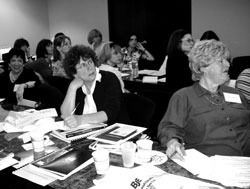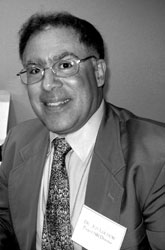
SIR: A Unique Program for Private
and Public Schools
by Joan Baum, Ph.D.
According to Professor Emeritus
Jed Luchow of the College of Staten Island, the four-year
phonics-based teacher training literacy program he directs—called Success in Reading
or SIR—is not only having “dramatic” effect
in the Hebrew day schools where it has been introduced, but
holds out extraordinary promise for the public schools.
The project, which runs under the
auspices of the Board of Jewish Education of Greater New
York, recently was given a grant by the Dichler Foundation
which will make it possible for SIR this September to work
with P.S. 163 on West 97th Street as part of that school’s partnership with Fordham University,
where SIR strategies will be introduced. So how is this literacy
program different from all others? Prof. Luchow, forthright,
thoughtful, organized and quiet-mannered—until he rifles
through his papers for corroborating evidence from his data
charts—notes that SIR, first, is fulfilling its mandate,
which is to provide yeshiva teachers, who need not be state
certified or have a Master’s degree, with the latest
research-based principles?and strategies about teaching reading
and writing in grades K-1.The goal is to lower the risk pool
of students who do not meet New York State benchmarks in various
literacy categories—a number that consistently hovers
at about 15%. Luchow also says that a concomitant goal is to
encourage intervention with these strategies at the earliest
possible time. For the Hebrew day schools, whose environments
do not typically include the kind of pre- and post-testing
engaged in by the public schools, the hope is to introduce
those teachers to the research-validated “screening tools” that
will help them assess “phonological awareness.”
Interest in phonics is hardly new,
but newer studies begun in the ’70s and widely disseminated in the ’90s
(particularly the work of Shepherd & Uhry and Vellutino & Scanlon)
show that decoding or word recognition (“the act of transcribing
a printed word back into speech”) is not the same as
reading comprehension, (“interpreting the message or
meaning of a text”). In other words, children who manifest
difficulty reading early on have not been adequately and sufficiently
exposed to “phonomenic awareness.” What to do?
Intervene early and provide children with intensive remediation
in decoding and writing letters. Critical to this approach
is the understanding that cognition is different from the “learned
skill” of being able to segment sounds. Remediation at
the end of the first grade is too late.
 To judge from the enthusiastic response
of the three-day training program held at the Board’s mid-Manhattan office this
month, the yeshivot and day school teachers, many of whom were
hearing about the research for the first time, and taking copious
notes, there was much to think about regarding strategies,
materials, and testing, some of which were demonstrated at
the various workshops. Here was Robin Rottenberg going through
a number of clever “games” that get children to
associate letter names and sounds (“all the kids do get
it at some point”); Flo Fruchter, rehearsing strategies
for reading aloud and for shared reading, particularly suitable
for those children for whom English is a Second Language, she
noted; and Lisa Robbins, a kindergarten evaluator who encouraged
the group to diagnose literacy levels from fill-in writing
samples.
To judge from the enthusiastic response
of the three-day training program held at the Board’s mid-Manhattan office this
month, the yeshivot and day school teachers, many of whom were
hearing about the research for the first time, and taking copious
notes, there was much to think about regarding strategies,
materials, and testing, some of which were demonstrated at
the various workshops. Here was Robin Rottenberg going through
a number of clever “games” that get children to
associate letter names and sounds (“all the kids do get
it at some point”); Flo Fruchter, rehearsing strategies
for reading aloud and for shared reading, particularly suitable
for those children for whom English is a Second Language, she
noted; and Lisa Robbins, a kindergarten evaluator who encouraged
the group to diagnose literacy levels from fill-in writing
samples.
But is Project SIR for all schools?
Aren’t public school
students different from those in the day schools? Luchow smiles:
there are myths and there are myths. The Jewish day schools
now include immigrant populations with deficiencies similar
to those associated with lower-income Americans and with children
whose non-reading struggles are all too familiar to teachers
of inner city youngsters. Out come Luchow’s charts about
a certain yeshiva in Far Rockaway, where three-year data show
a “phenomenal” reduction in the overall number
of at risk boys there and a clear “accomplishment” in
first graders being able to decode both Hebrew and English
letters! Clearly, he believes, good strategies transcend culture
and ethnicity, and good data drive efficient pedagogical reform.#
